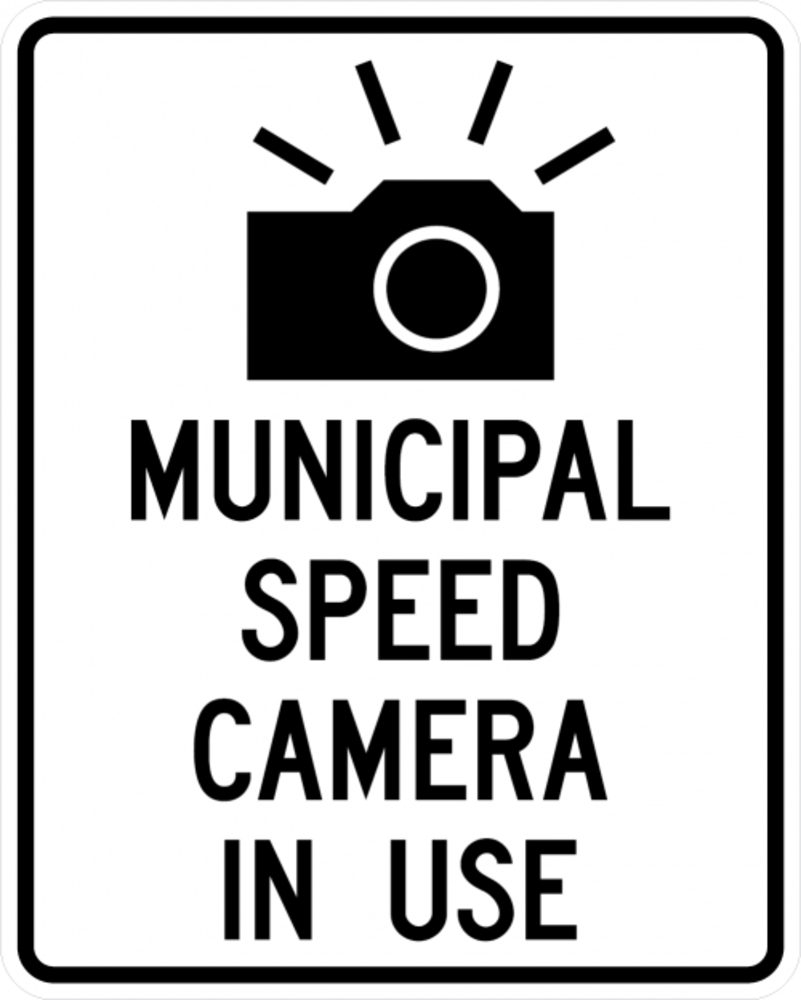Automated Speed Enforcement
Automated Speed Enforcement
Automated Speed Enforcement (ASE) uses speed cameras to enforce speed limits. These cameras are a cost-effective way to reduce speeding, improve safety, and ensure drivers obey speed limits. Here's what happens if you're caught speeding by an ASE camera.
- The camera takes a picture of your vehicle.
- A provincial offences officer reviews the image.
- A ticket is mailed to the registered owner of the vehicle within 30 days.
Avoiding a ticket is easy: just don't speed. Please slow down to help keep our communities safe.
Statistics from aseontario.com (2019)
ASE Signage
Signs near ASE camera locations indicate where cameras are coming soon and when they are active. The speed limit signs change when cameras are in use.
"Coming Soon" Signage:
“Coming soon” signs must be installed at least 90 days before the ASE cameras are activated to give drivers advanced notice. "Testing" signs may be put up to inform drivers that cameras are being tested but are not yet enforcing speed limits.
"Municipal Speed Camera in Use" Signage:
These signs are displayed only when cameras are active and traffic tickets are being issued.
Speed Limit Signage:
When cameras are in use, signs indicate the posted speed limit for that section and roadway. ASE can be used on the streets with a posted speed limit of up to 80 km/h. School zones and community safety zones may have reduced speed limits. It is important that drivers are aware of the posted speed limit for the road section they are travelling on.
ASE Camera Locations
In Sault Ste. Marie, ASE cameras will be placed in school zones or community safety zones. These zones are designated through the Traffic By-law. In these zones, fines for certain offenses, including speeding, are doubled.
Locations for the ASE program will be selected based on data showing areas where drivers frequently exceed the speed limit. Cameras will be installed and rotated to different locations every few months.
ASE Tickets and Fines
ASE cameras capture the licence plates of vehicles that exceed the speed limit. The ticket will include the photo taken by the ASE camera and an enlargement of the plate. It is mailed to the registered plate holder at the address on file with the Province of Ontario and will arrive within 30 days of the violation.
The penalty is only a fine. Tickets issued via ASE do not result in demerit points.
Like police-issued speeding tickets, the fine depends on how much the driver exceeded the speed limit. Fines are set by the Ontario Court of Justice Chief Judge and are listed in Schedule D of the Highway Traffic Act. Fines are doubled in community safety and school zones, even outside of school hours.
There are options for ticket payment or response to the provincial offence. Failure to pay your ticket could result in the inability to renew your driver's license or renew your vehicle registration.
How the Funds are Used
- The municipality uses the funds from fine payments to offset the costs of the ASE program, including camera leases, signs, Provincial Offences Officers, office, and miscellaneous expenses.
- The victim fine surcharge portion is submitted to the Province, similar to other ticket offenses. The municipality retains any net fine revenue after expenses.
- If there is a surplus of revenue over expenses, these funds will be reinvested by the City into the ASE program, other road safety, or traffic calming initiatives.
How do we know ASE will be effective?
Automated speed enforcement has been proven effective through numerous studies and real-world applications. Research consistently shows that these systems significantly reduce speeding and related traffic accidents. Cities using automated speed enforcement often see improved road safety, including fewer fatal and serious injury crashes, highlighting its effectiveness in traffic management and public safety.
- Ottawa: Saw a 200% increase in compliance with the posted speed limit.
- Quebec: Reduced average speeds by 13.3 km/h and crashes by 15-42%.
- Guelph: Saw an average speed reduction of 19.4%.
- Saskatchewan: Saw a 17% decrease in average speeds and a 63% reduction in speed-related casualties.
- New York City: Reduced speeding by 63% and pedestrian injuries by 23%.
Contact us:
Phone: 705-759-5378
Email: engineering@cityssm.on.ca
TTY: 1-877-688-5528
Location: Ronald A. Irwin Civic Centre, 99 Foster Drive
Frequently Asked Questions
The focus is safety. Revenues from ASE should cover operating costs. If any revenue is generated, it will be used for other road safety initiatives.
Fines vary according to the speed recorded by the ASE camera and are determined by the Ontario Court of Justice. In general, the higher the speed, the higher the fine. The total payable indicated on the ticket includes the set fine and the victim fine surcharge, as well as potential additional fees for plate denial and missing hearings.
ASE systems are verified for accuracy every 12 months. A certificate of accuracy is required for each device. You can challenge the accuracy with evidence to the contrary to present under oath or affirmation at trial.
Due to privacy laws, ASE systems cannot capture images of drivers or passengers. Therefore, tickets are issued to the registered owner of the vehicle. Under the Highway Traffic Act, drivers can be held responsible for how their vehicles are being used.
Clear signs will be posted in each school zone and community safety zone where ASE is active. Additionally, signs will be installed 90 days before tickets are issued to give drivers ample notice.
ASE complements traditional enforcement by allowing police to focus on other critical tasks. ASE provides continuous monitoring, helping to ensure safety for school children and other road users. Consistent use of ASE can lead to long-term changes in driver behaviour.
No. Speed limits are laws, not guidelines. Staying at or below the posted limit ensures no ticket will be issued.
Yes, you can.
- Pay the fine.
- Submit the penalty notice to the administration office for review by a Screening Officer. If you are unsatisfied with the Screening Officer's decision,
- You can request a hearing with a Hearing Officer. The Hearing Officer's decision is final. If the matter remains unresolved, the registered owner’s license plate may be denied.




